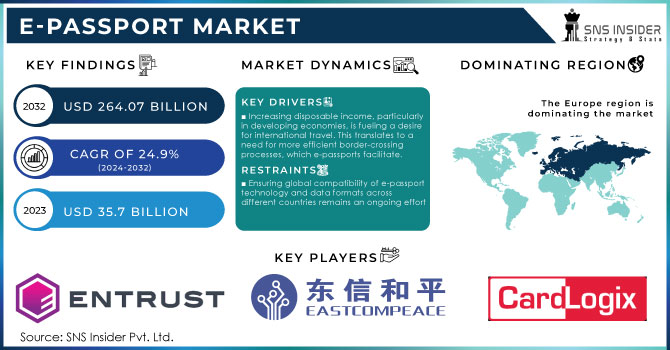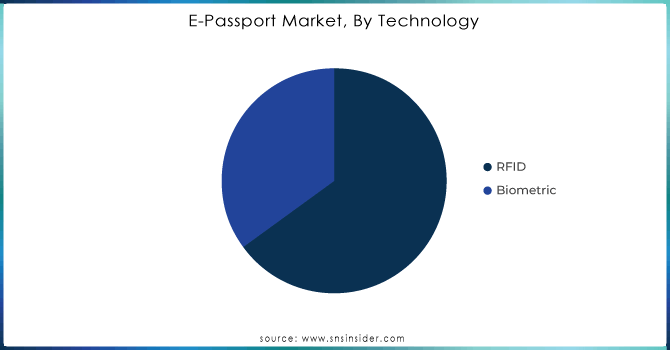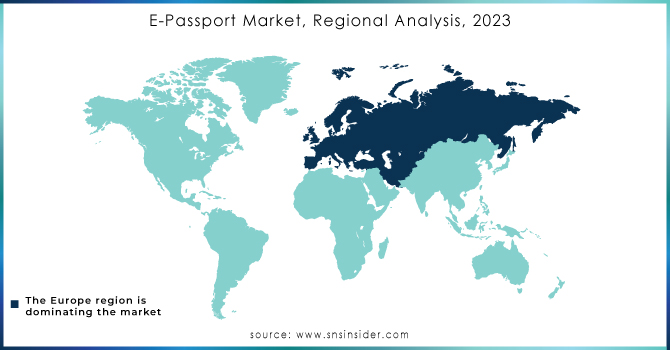E-Passport Market Report Scope & Overview:
The E-passport Market was valued at USD 32.67 Billion in 2023 and is expected to reach USD 145.45 Billion by 2032, growing at a CAGR of 18.08% over the forecast period 2024-2032.

Get more information on E-passport Market - Request Free Sample Report
Rising demand for secure efficient travel solutions is a primary driver of the e-passport market, and further growth can be expected. With international travel on the increase, countries are implementing advanced technologies including RFID and biometrics into their border control operations to step up their protections against identity theft, fraud, and security breaches. With the inclusion of chips, the e-passport can store biometric information that can uniquely identify a person, fingerprints, and/or facial recognition of a person, thus making it harder for unauthorized or non-legitimate people to clone or alter documents. In part, greater security is driving this especially as governments work to protect citizens and preserve the very definition and integrity of travel documentation. There are more than 1 billion ePassports issued currently, by 174 countries as of December 2024. Biometric passports likely accounted for about 24.5 million passports in the US in 2024. The adoption of ePassports is growing rapidly, highlighting the global trend of secure and efficient travel documentation.
The e-passport market is also being driven by rising biometric system adoption at airports and immigration centers around the world. This speeds up and simplifies the passport verification process, which reduces the time taken to cross a border. The demand for e-passports is also driven by growth in international tourism, business travel, and the worldwide demand for digital identity solutions. E-passports are being integrated with biometrics as part of a global digital transformation of the governmental and security infrastructure that will ultimately make travel easier and safer for people everywhere. International tourist numbers topped 1.4 billion and tourism receipts USD 1.6 trillion in 2024. As travelers using biometrics at airports has climbed to 46%, the preference for biometrics over conventional methods is at 75%. TSA's biometric rollout will take place at 400 U.S. airports, while India operates its Digi Yatra system at 28 different airports, covering 90% of the country's domestic air travel.
Market Dynamics
Key Drivers:
-
Government Investments in Border Security and Biometric Systems Drive E-passport Market Growth
Government investments in identity management and border security systems are one of the major factors responsible for the growth of the e-passport market. As the threat of terrorism, illegal immigration, and organized crime grows, governments across the globe are prioritizing border security. The advanced biometric capabilities of e-passports provide a trustworthy and secure means of verifying the identity of travelers, significantly reducing the opportunity for fraud and impersonation. Numerous nations have overhauled their passport delivery techniques to fulfill the global norms of the International Civil Aviation Organization (ICAO), which promotes the utilization of biometric info in passports to enhance outskirt safety. Such government initiatives and regulations have been instrumental in the global acceptance of e-passports, as nations rush to meet the changing landscape of security requirements while safeguarding the lives of citizens and visitors alike. The U.S. Department of Homeland Security approved USD 103.2b for 2024 for border security, but only USD 60.4b for discretionary purposes. ICE spending climbed from USD 3.3 billion in 2003 to USD 9.6 billion. With practices dating back to 2020, the U.S. has invested USD 7.8 billion dollars into its immigration technologies and working with 263 partners who specialize in biometric systems.
-
E-passport Adoption Accelerates with Digital Technologies Frictionless Travel and Smart Airport Integration
Moreover, the increasing adoption of digital technologies and initiatives aimed at ensuring smooth human-to-human migration is another factor fueling the e-passport market. At the same time, increasing numbers of travelers want speedier access to cross borders without sacrificing security. E-passports facilitate the integration of biometrics, facial recognition, and RFID technology, which can significantly improve the immigration process, reducing the waiting period at the airport, and enhancing the overall travel spending experience. Growth of “smart” airports Automated self-check-in kiosks and biometric scanners could develop in both of these types of airports, creating greater demand for e-passports, as e-passports include advanced features that facilitate seamless verification on the part of the digital travel ecosystem. As e-passports enable efficient, fast, and secure border processing of millions of travelers around the globe, their adoption rate is on the rise amidst the push to contactless and frictionless travel.
Restrain:
-
Challenges of Technological Interoperability Data Privacy and Security in E-passport Adoption
Technological interoperability and standardization are some of the key challenges restraining the growth of the e-passport market. The need for data encryption, biometrics, and passport chip technology differs from country to region, and traveling across borders also brings with it compatibility issues. Such a lack of harmonization can obstruct the global uptake of e-passports and may result in seeming inconsistency in the manner in which biometric data is stored and processed, causing inconvenience or errors in travel document validation. There is also a major hurdle in data privacy and cyber-attack. Since e-passports include sensitive biometric information like fingerprints and facial images they present a lucrative target for cyberattacks and data breaches. This personal information needs to be protected against identity theft or use by someone else. Keeping e-passports secure from hacking and unauthorized access is a complex, ongoing challenge for governments and other organizations, which need to continuously upgrade security protocols.
Segment Analysis
By Technology
In 2023, RFID held the highest share of the e-passport market at 63.6%, largely due to its widespread presence and widespread adoption across several countries. RFID technology has proven methods of securely storing and transmitting information from an embedded chip in e-passports and allows for faster, automated border control procedures. The system also acts as an unattended contactless authentication method that allows travelers to clear security passages without physical contact. RFID has a significant market share due to its simplicity, low cost to implement, and reliable performance, and many countries are using RFID-based electronic passports for international travel.
Biometrics is expected to have the highest CAGR growth in 2024-2032 owing to the rising security concerns and the need for stronger identity verification of travelers. Fingerprint recognition, facial recognition, and iris scanning are all considered biometric identifiers and are more secure than traditional RFID because their uniqueness is a lot higher and they cannot be forged or replicated, unlike RFID cards. Even in e-passports, with governments and moving authorities placing greater importance on preventing fraud, biometrics are coming to play larger roles. But this change is actually in line with the whole new paradigm shift going around the globe towards better digital ways of travel through Made Easy, Safe, and Secured Travels. As the technology gets polished and cheaper, so will its expansion which will make the global travel experience a lot more secure and efficient.
By Application
In 2023, leisure travel held the largest share in the e-passport market at 55.2% owing to the rise in international tourist arrivals and the wider accessibility of global travel. As disposable incomes rise and international travel is easier to book, the number of travelers hitting the skies, ocean, and rails has also increased and so has the need for travel documents that facilitate safe and secure travel. As the thirst for long trips, holidays and cultural gastronomy has driven the expansion of tourism, e-passport use has greatly spread among holiday travelers, providing a reliable and rapid option for border processing. This dominance is also bolstered by the commonality of e-passports in tourism-heavy areas such as Europe, North America, and Asia.
Business travel is expected to witness the highest CAGR growth from 2024-2032 owing to the swift internationalization of sectors and the rising demand for cross-border collaboration and meetings. Overseas expansion requires more business-related travel, increasing the adoption rate of e-passports from corporations as well as the government. E-passports, which incorporate biometric information and RFID technology, provide the more fluid, secure, and efficient border crossings that business travelers often need. Also, the lifting of international business activities after a long apocalyptic shutdown and the upsurge of international conferences and trade shows, along with work-from-home setups, will also boost business tourism growth.

Need any customization research on E-passport Market - Enquiry Now
Regional Analysis
In 2023, Europe held the largest share of the e-passport market with 38.2% due to the significant infrastructure and adoption of secure travel technologies in the region. The deployment of e-passports in many European nations, including the UK, Germany, and France has been close to reaching the maximum standardized execution of the mandatory travel enforced globally by the International Civil Aviation Organization (ICAO). While its ambitions for military modernization are still developing, the EU has had more success with investments in border security and digital identity projects like the European Travel Information and Authorization System (ETIAS), which is designed to improve travel security at EU frontiers. With nations such as Sweden and Estonia already leading the charge towards biometric e-passports, and other governments exploring systems too, it is clear the region is forcing the pace of development further and driving the market.
Asia Pacific region is anticipated to witness the highest CAGR from 2024 to 2032 owing to high growth in international travel and the rising need for secure travel documents. Driven by increasing security and countermeasures worries, a lot more nations such as China, India, and Japan are earmarking bigger expense budgets for biometric and RFID e-passports. China, for example, has made considerable headway on the biometric passport front, including fingerprint and facial recognition to ease the pressure on border control departments. Likewise, India has also been updating the passport system with new methods such as e-passports that have RFID Chips and biometric information, due to having the second largest population with many more international travelers coming from India. This expansion will be boosted by the increasing saturation of the digital transformation in the Asia Pacific region and the demand for travel with high growth in emerging economies that will remain one of the vectors for the implementation of e-passports in the future.

Key players
Some of the major players in the E-passport Market are:
-
Gemalto (Thales Group) (eTravel, Premium eCover)
-
IDEMIA (eID, ePass)
-
Bundesdruckerei GmbH (Polycarbonate Data Pages, ePassport Personalization Systems)
-
Mühlbauer Group (ePassport Inlays, ePassport Personalization Systems)
-
De La Rue plc (ePassport Printing Solutions, ePassport Personalization Systems)
-
Veridos GmbH (ePassport Solutions, eID Cards)
-
Oberthur Technologies (Idemia Group) (ePassport Solutions, eID Cards)
-
IDEX ASA (Fingerprint Sensors, Biometric Cards)
-
Mühlbauer Holding AG (ePassport Inlays, ePassport Personalization Systems)
-
Shanghai Mite Speciality & Precision Printing (Security Printing Services, ePassport Printing)
-
India Security Press (Passport Printing, Security Printing)
-
Beijing Jinchen Cvic Security Printing (Security Printing Services, ePassport Printing)
-
Japan National Printing Bureau (Passport Printing, Security Printing)
-
Goznak (Security Printing, ePassport Printing)
-
Casa da Moeda do Brasil (Security Printing, ePassport Printing)
-
Canadian Bank Note (Security Printing, ePassport Printing)
-
Royal Mint of Spain (Security Printing, ePassport Printing)
-
Polish Security Printing Works (Security Printing, ePassport Printing)
-
Istituto Poligrafico e Zecca dello Stato (Security Printing, ePassport Printing)
-
Iris Corporation Berhad (ePassport Solutions, Biometric Systems)
Some of the Raw Material Suppliers for E-passport companies:
-
3M
-
DuPont
-
Eastman Chemical Company
-
Xerox Corporation
-
BASF
-
Arjowiggins
-
U.S. Banknote Corporation
-
LG Chem
-
Schreiner Group
-
Avery Dennison Corporation
Recent Trends
-
In June 2024, The Netherlands introduced new identity documents featuring LASINK™ Helios by IDEMIA, enhancing security with advanced biometric and optical technology.
-
In February 2024, Veridos launched Latvia's first-ever ePassport featuring a color photo, enhancing both security and design. The innovative document was recognized with the "Regional ID Document of the Year Award" at the 2024 HSP conference.
-
In January 2025, IDEX Biometrics ASA partnered with LIFE CARD to launch biometric payment cards in Japan, marking the country's first commercial deployment. This innovation is set to enhance security and convenience in Japan's payments market by 2025.
| Report Attributes | Details |
|---|---|
| Market Size in 2023 | USD 32.67 Billion |
| Market Size by 2032 | USD 145.45 Billion |
| CAGR | CAGR of 18.08% From 2024 to 2032 |
| Base Year | 2023 |
| Forecast Period | 2024-2032 |
| Historical Data | 2020-2022 |
| Report Scope & Coverage | Market Size, Segments Analysis, Competitive Landscape, Regional Analysis, DROC & SWOT Analysis, Forecast Outlook |
| Key Segments | • By Technology (RFID, Biometrics) • By Application (Business Travel, Leisure Travel) |
| Regional Analysis/Coverage | North America (US, Canada, Mexico), Europe (Eastern Europe [Poland, Romania, Hungary, Turkey, Rest of Eastern Europe] Western Europe] Germany, France, UK, Italy, Spain, Netherlands, Switzerland, Austria, Rest of Western Europe]), Asia Pacific (China, India, Japan, South Korea, Vietnam, Singapore, Australia, Rest of Asia Pacific), Middle East & Africa (Middle East [UAE, Egypt, Saudi Arabia, Qatar, Rest of Middle East], Africa [Nigeria, South Africa, Rest of Africa], Latin America (Brazil, Argentina, Colombia, Rest of Latin America) |
| Company Profiles | Gemalto (Thales Group), IDEMIA, Bundesdruckerei GmbH, Mühlbauer Group, De La Rue plc, Veridos GmbH, Oberthur Technologies (Idemia Group), IDEX ASA, Mühlbauer Holding AG, Shanghai Mite Speciality & Precision Printing, India Security Press, Beijing Jinchen Cvic Security Printing, Japan National Printing Bureau, Goznak, Casa da Moeda do Brasil, Canadian Bank Note, Royal Mint of Spain, Polish Security Printing Works, Istituto Poligrafico e Zecca dello Stato, Iris Corporation Berhad. |
| Key Drivers | • Government Investments in Border Security and Biometric Systems Drive E-passport Market Growth • E-passport Adoption Accelerates with Digital Technologies Frictionless Travel and Smart Airport Integration |
| RESTRAINTS | • Challenges of Technological Interoperability Data Privacy and Security in E-passport Adoption |

